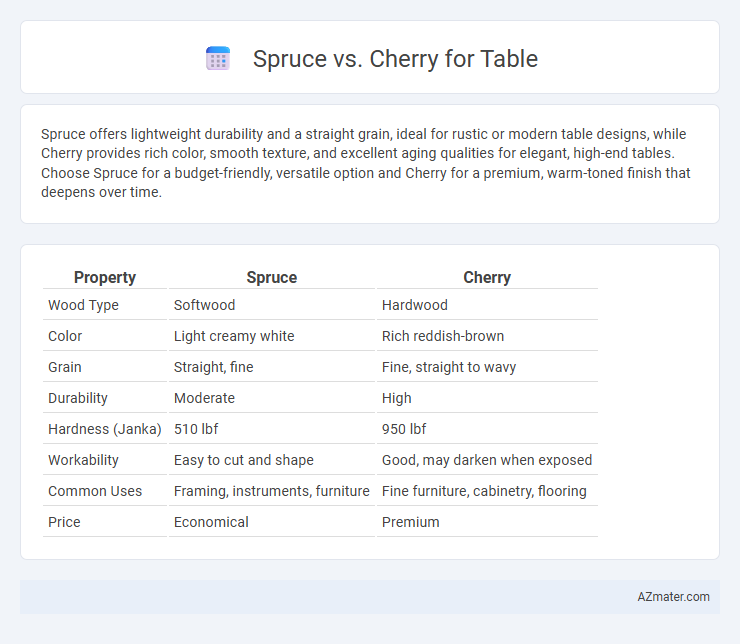Spruce offers lightweight durability and a straight grain, ideal for rustic or modern table designs, while Cherry provides rich color, smooth texture, and excellent aging qualities for elegant, high-end tables. Choose Spruce for a budget-friendly, versatile option and Cherry for a premium, warm-toned finish that deepens over time.
Table of Comparison
| Property | Spruce | Cherry |
|---|---|---|
| Wood Type | Softwood | Hardwood |
| Color | Light creamy white | Rich reddish-brown |
| Grain | Straight, fine | Fine, straight to wavy |
| Durability | Moderate | High |
| Hardness (Janka) | 510 lbf | 950 lbf |
| Workability | Easy to cut and shape | Good, may darken when exposed |
| Common Uses | Framing, instruments, furniture | Fine furniture, cabinetry, flooring |
| Price | Economical | Premium |
Spruce vs Cherry for Table: Key Differences
Spruce offers a lightweight, pale wood option with a fine grain, ideal for minimalist table designs, while Cherry features a rich, reddish-brown hue and dense grain that darkens over time, providing a warm, luxurious look. Spruce tends to be softer and less durable compared to Cherry, which is harder and more resistant to dents and scratches, making Cherry tables more suitable for high-traffic use. The cost difference also plays a role, as Cherry is generally more expensive due to its durability and aesthetic appeal, whereas Spruce is a more budget-friendly choice for functional, rustic-style tables.
Wood Grain and Appearance Comparison
Spruce wood features a light color with a straight, uniform grain that gives tables a clean and minimalistic appearance, ideal for modern or rustic decor. Cherry wood exhibits a rich, warm reddish-brown hue with a fine, satiny grain that darkens and deepens over time, adding elegance and character to furniture. The contrast in grain patterns and color aging between spruce and cherry makes cherry more suitable for statement pieces, while spruce fits well in bright, casual settings.
Durability and Hardness: Which Lasts Longer?
Spruce is a softwood known for its lightweight properties but lower durability and hardness compared to hardwoods, making it more prone to dents and scratches over time. Cherry wood is a hardwood prized for its moderate hardness and excellent durability, which allows it to withstand daily wear and maintain its structural integrity for many years. When choosing between spruce and cherry for tables, cherry offers superior longevity and resistance to damage, ensuring a longer-lasting piece of furniture.
Table Aesthetics: Color and Finish Options
Spruce offers a light, pale yellow hue with a smooth, consistent grain that enhances modern and minimalist table aesthetics. Cherry wood features rich, warm reddish-brown tones that deepen over time, providing an elegant and classic finish often favored for traditional or rustic tables. Both woods respond well to stains and finishes, but Cherry's natural color variation and ability to develop a deep patina make it particularly versatile for achieving luxurious and timeless table designs.
Workability: Ease of Crafting with Spruce vs Cherry
Spruce offers lightweight softness that makes it easy to cut and shape, ideal for handcrafted table details and intricate designs. Cherry wood provides a hardwood density that requires more effort but allows for a smoother finish and greater durability in table construction. Both woods respond well to sanding and finishing, but spruce is preferred for rapid crafting and cherry for polished, long-lasting results.
Cost Analysis: Spruce vs Cherry Table Pricing
Spruce tables generally offer a more cost-effective option compared to cherry tables, with prices often 30-50% lower due to the wood's faster growth and greater availability. Cherry wood, known for its rich color and durability, commands a premium price reflecting its hardwood quality and longer aging process. Choosing spruce can significantly reduce budget expenses while still providing a sturdy table, whereas cherry tables represent a higher investment for luxury and longevity.
Maintenance and Longevity in Daily Use
Spruce tables require regular sealing and protection from moisture to prevent warping and dents, while cherry wood offers natural resistance to wear and ages gracefully with a rich patina. Cherry's dense grain structure enhances durability, making it less prone to scratches compared to the softer spruce. For daily use, cherry tables typically offer longer-lasting appeal and easier maintenance, demanding only occasional polishing to maintain their finish.
Sustainability and Environmental Impact
Spruce wood is highly sustainable due to its fast growth rate and wide availability, minimizing deforestation impacts when sourced responsibly. Cherry wood, while slower-growing, offers greater durability, but its harvesting requires more careful forest management to prevent habitat disruption. Choosing FSC-certified spruce or cherry ensures eco-friendly practices, reducing carbon footprints and supporting sustainable forestry.
Best Uses: Matching Table Style to Wood Type
Spruce tables are best suited for rustic or Scandinavian-style interiors, where their light color and straight grain enhance a minimalist, airy aesthetic. Cherry wood's rich, warm tones and smooth grain make it ideal for traditional or formal dining tables, adding elegance and depth to classic settings. Matching table style to wood type optimizes durability and visual appeal, with spruce excelling in casual, light-use environments and cherry in high-traffic, sophisticated spaces.
Final Verdict: Choosing Between Spruce and Cherry for Tables
Cherry wood offers rich color, durability, and fine grain, making it a premium choice for tables that age beautifully over time. Spruce, while lighter and more affordable, is softer and less resistant to dents, better suited for rustic or temporary furniture. The final decision depends on balancing budget with desired longevity and aesthetic, favoring cherry for lasting elegance and spruce for cost-effective, lightweight tables.

Infographic: Spruce vs Cherry for Table
 azmater.com
azmater.com